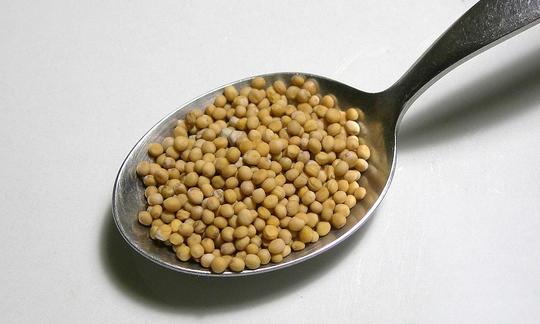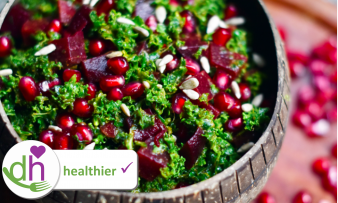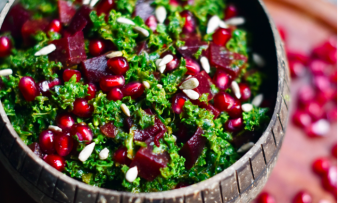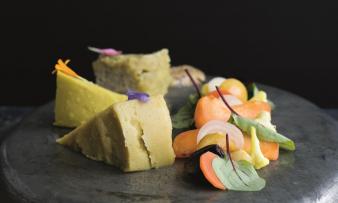Table of contents
White or yellow mustard seeds come from white mustard ( Sinapis alba ), also known as yellow mustard. They have a pleasant smell and a sharp taste. Organic mustard made from them can be used in many ways in the kitchen as a spice paste.
Use in the kitchen
How can you eat mustard seeds? Mustard seeds can be mashed (and fermented) with vinegar and salt to make mustard (regionally known as mustard or mostert). They are used to season pickled cucumbers and other vegetables (e.g. zucchini ). In England, the pickled mustard vegetable, which gets its yellow color from turmeric and its exotic flavor from many other spices, is known as piccalilli (or piccalilli sauce). Suitable vegetables include cauliflower, cucumbers, carrots, green beans and onions .
Undamaged, whole mustard seeds are tasteless. The sharp aroma is only created by chewing, crushing or grinding the seeds and exposing them to liquid. You can find out how the typical mustard taste comes about in the "Further information" chapter below.
Whole, pickled mustard seeds are often referred to as mustard caviar. Whole mustard seeds are also used as a spice for roasting, braising and cooking vegetables (e.g. green beans). Whole, crushed or ground mustard seeds give dips, sauces and marinades a particularly appealing spiciness. In general, white seeds are less spicy than brown and black mustard seeds . 20
Mustard seeds, combined with sweet components (such as honey, raw sugar, agave syrup ), with fruits ( figs, apples, pears, peaches ) or dried fruits ( raisins, apricots, figs ), are less spicy in taste.
Can you eat mustard seeds raw? Mustard seeds are definitely edible raw. Young, green and tender seed pods are also a great fresh spice for raw food, vegan or vegetarian recipes. Even germinated, i.e. as organic sprouted seeds, they give raw food salads a fresh kick and provide vitamins all year round.
Raw, spicy leaves, young shoots and stems (April-June) are used as healthy and digestive vegetables, for example Indian cuisine uses the herb like spinach. If you want to use larger quantities as a vegetable, you can cook the green parts of the plant to reduce the spiciness.
Because of the highly irritating essential oil, seeds or leaves are not suitable for tea. 1
Vegan recipe for coarse-grained mustard
Ingredients (one jar): 20 g organic mustard seeds (yellow, whole), coarsely ground, 10 g yellow mustard powder, 1 garlic clove (raw), 30 g apple cider vinegar (5% acid), 1 tbsp honey, salt, turmeric, drinking water as needed.
Preparation: For the vegan recipe with mustard seeds, mix all the ingredients and puree them for a few seconds until you reach the desired consistency. Add water as needed. Since the mixture will swell, prepare it until it is too liquid rather than too solid.
Fresh or dried organic herbs such as thyme, rosemary, dill, tarragon or wild garlic give white mustard a special note. A fruity-sweet result can be achieved with fig, date or mango puree and lemon or orange peel give it a fresh taste. Chili or wasabi paste add more spiciness. Recipes with mustard seeds (raw) are varied.
When grinding the mustard seeds (yellow, whole), high temperatures can arise and lead to a particularly sharp or bitter taste. For this reason, the optionally boiled vinegar-water mixture should be allowed to cool before the next preparation step.
The finished mustard or spice mustard can be kept in the fridge for several weeks. For better shelf life, sprinkle the surface with rapeseed oil . Before eating for the first time, let the mustard steep for two to three days so that the full aroma develops.
Vegan recipes with yellow-white mustard seeds can be found under the note: " Recipes that have the most of this ingredient ".
| Not only vegans or vegetarians should read this: Vegans often eat unhealthily. Avoidable nutritional errors . |
Purchasing - Storage
The seeds are available in raw, conventional and organic quality. You can buy white mustard as a spice in supermarkets such as Coop, Migros, Spar, Billa, Edeka or Rewe . We have not yet found any whole seeds in the standard range of supermarkets such as Denner, Volg, Aldi, Lidl or Hofer . Organic supermarkets ( Denn's Biomarkt or Alnatura ) often have organic mustard seeds. Other addresses, also for raw food quality, are health food stores, organic shops, farm shops and weekly markets as well as online and spice retailers. Regardless of the season, the raw seeds (dried) are available all year round declared as a spice or sprouting seed. They are packaged in spice bags, cans, jars and small sacks in container sizes from 25 g to 1 kg.
In the pharmacy you can get seed powder ( mustard powder ) under the name "defatted mustard flour" (or "yellow defatted mustard flour") or as: Semen Sinapis pulveratum exoleatum.
The availability of yellow mustard seeds varies depending on the size of the store, catchment area, etc. If you are interested, click on our recorded food prices for the DA-CH countries (above under the ingredient image). There you will find current prices from various supermarkets and their price development.
Found in the wild
The annual mustard seed plant reaches heights of between 30 and 120 cm. The oval, pinnately divided leaves are arranged alternately on the angular and upright stems. Leaves that grow higher up are stalked. The bristly hairy pods stand horizontally from the stem and contain up to eight white seeds. The disc-shaped flowers are sulphur yellow. They have an intense and pleasant smell that is reminiscent of vanilla . 2 The flowering period is from May, June to September, October. 2,3
The heat-loving plant, which is native to the Mediterranean region, is found there and in Central Europe in fields, wasteland, rubble heaps, ruderal areas, in gardens or on roadsides, where it is wild and unstable. It is a dominant species that helps shape the appearance of the habitat. 2,3,4,5
Storage tips
Undamaged raw seeds (also known as mustard seed or mustard grain) can be kept for months or even years if stored correctly. They should be stored in an aroma jar or other sealable spice container, protected from light, in a dry and cool place.
Ingredients - Nutritional values - Calories
Here we realistically show you the ingredients of spices and herbs per 1 g (instead of per 100 g as usual).
1 g of Sinapis alba (raw) has a calorie content of 4.87 kcal. It contains 0.29 g of fat, 0.35 g of carbohydrates and 0.25 g of protein per gram of spice. 6
The iron content is high at 0.18 mg/1g, even if you only eat a small amount of mustard. Fennel seeds and curry powder have similar values. Dried thyme has significantly more of this trace element at 1.24 mg/1g.
The active ingredients are approximately 5% mucilage in the seed shells 9,13 and mustard oil glycosides, including sinalbin. After the enzymatic splitting of sinalbin by the plant's own enzyme myrosinase, non-volatile essential mustard oil is produced, which ensures the consistent spiciness. 5,7 The fatty acids in the seed oil consist of 41.3% erucic acid, 8 as well as significant amounts of alpha-linolenic acid (0.39 g/1g) and linoleic acid (0.26 g/1g). This results in a ratio of omega-6 to omega-3 fatty acids of 1:1. 6
Sinapis alba has significantly higher levels of mucilage than other mustard species, which contain less than 1%. 9 Black mustard ( Brassica nigra ) and brown mustard ( Brassica juncea ) contain the glucosinolate sinigrin as their most important component, which releases volatile essential oils during hydrolysis. 10,11,12
The complete ingredients of yellow-white mustard seeds, the coverage of the daily requirement and comparison values with other ingredients can be found in our nutrient tables. In the article Nutrients explained you will get a detailed insight into the topic.
Effects on health
Are white mustard seeds healthy? Sinapis alba has skin-irritating, bacteriostatic, circulation-stimulating, 7,13 anti-inflammatory and analgesic properties. Mechanism of action: the odorless sinalbin is processed into a paste to produce the skin-irritating p-oxy-benzyl mustard oil, which is responsible for the general anti-inflammatory effect and the analgesic effect via the counter-irritant effect. 7
The antioxidant, antimicrobial and antiproliferative (growth-inhibiting) properties of mustard seed extracts were investigated on healthy and tumor cell lines. Sinalbin showed lower antiproliferative effects when isolated, and higher ones when the enzyme myrosinase was added. There are potential approaches to cancer prevention here. 8
In order to clarify the mechanism of action of the immune regulation activity of Sinapis alba, the skin penetration of the seed extract was investigated in vitro and in vivo (in animals). The measurable changes in important markers of the immune defense (Langerhans cells, local cytokine release) explain the effect of the seeds against asthma and bronchitis. 14
In an animal model, anti-inflammatory effects of aqueous ethanol extracts of the seeds against acute and chronic inflammatory processes were observed in mice with induced ear edema. These effects are due to the partial suppression of mRNA expression. 15
Dangers - Intolerances - Side effects
Sinapis alba is not recommended for children under six years of age and people with kidney disease, as such circumstances are considered contraindications. 5 Severe circulatory damage, varicose veins and other venous diseases are not good conditions for the use of mustard seeds. Caution is advised for sensitive, predisposed people. 10
If used for too long, side effects such as skin and nerve damage or irritation of the renal epithelium can be expected. 7 If mustard compresses or plasters are used for too long, blistering can occur, often with festering, poorly healing ulcers and necrosis. 10 No interactions are known. 7,13
In cooking, you should not overdose on mustard. The irritating essential oil should never be taken internally 11 and tea made from seeds should be avoided. 10
Bisphenol F (BPF) is formed during the production of preparations from Sinapis alba, which is associated with sinalbin. BPF appears to be as toxic as BPA and is considered to have a weak hormone activity. Studies have not been able to determine a non-toxic dose, and in animal experiments the lowest daily dose (20 mg/kg body weight) was toxic. Due to the small average consumption of mustard, the Swiss Federal Office for Food Safety and Veterinary Affairs ( FSVO ) classifies the health risks associated with BPF as low. 16
Erucic acid, which is harmful to health, is a component of mustard oil, which is why it is not allowed for consumption in Europe. Possible consequences include pathological changes to the heart muscle and fatty heart disease. 1 The maximum content of erucic acid in mustard as a seasoning is 35 g of erucic acid per kg of mustard, and the value for oil from mustard seeds is 50 g/kg. 22
Mustard is one of the 14 most common allergens that must be clearly indicated on packaging or in restaurants. Cross-reactions with other cruciferous plants or pollen are also possible.
Use as a recognized medicinal plant
Sinapis alba is listed in the American, Belgian, French, Portuguese and Swiss pharmacopoeias. 5 HMPC ( Committee on Herbal Medicinal Products ) and ESCOP ( European Federation of National Societies of Phytotherapy ) have not yet described the plant.
Indications according to Commission E are catarrh of the respiratory tract, chronic degenerative joint diseases and soft tissue rheumatism, which are treated externally with poultices. 7
The remedy is used externally only. Immediately before use, mix 4 tablespoons of seed powder with warm water 7 (not hot! Or > 60 °C) 10 until it reaches a paste-like consistency. The daily dose is 60-240 g. 7
Before treatment, it is recommended to apply a fatty ointment. For children, the compresses remain on the skin for about 5-10 minutes and for adults about 10-15 minutes. Depending on the sensitivity of the skin, the application time must be shortened individually. After 3 minutes, check for redness and a rise in skin temperature. This ointment can be applied up to 4 times a day for a maximum of two weeks. Mustard plasters (Charta sinapisata) can also be used. 3,7,10,11
Mucus-forming plants are used successfully as a prophylactic to supplement or strengthen synthetic medicines against hyperacidity or gastrointestinal ulcers. The most commonly used herbs include mustard (yellow), linseed, psyllium, fenugreek seeds and marshmallow. 17
Folk medicine - natural medicine
In folk medicine, the seeds are traditionally considered to be effective for external compresses to promote blood circulation, to relieve joint diseases and rheumatism, for coughs and bronchitis, to reduce fever, to promote digestion and to stimulate the metabolism. 3 Other indications in traditional medicine are neuralgia, 7 pain in the arms and legs, sprains, boils, abrasions, skin rashes, chilblains and thrush. 18
Ecological footprint - animal welfare
The ecological CO 2 footprint of mustard seeds depends on several factors, including the cultivation method, the country of origin and the corresponding transport and also the type of packaging. In the production of mustard seed oil, electricity consumption, the use of fertilizers and field emissions also have an impact on the environment. 23 Despite extensive research, however, we were unable to find any precise figures on the ecological footprint of mustard seeds. The amount of water required to produce 1 kg of mustard seeds is 2809 liters. 24
The mustard plant is susceptible to a variety of pests that can cause crop losses. To prevent this, pesticides and herbicides are often used in conventional agriculture, but residues from these can also be detected in the end product. 25 Ideally, when shopping, you should look for products that have been organically grown, as the use of synthetic pesticides is prohibited here.
The heat-loving plant copes well with dry and hot years. Apart from the green manure measures, it has a variety of soil-improving properties. With its branched and deep root system, it counteracts soil compaction and plays a role in soil health and soil stability. 26
Animal protection - species protection - animal welfare
White mustard is a popular bee pasture and a food station for flies, beetles and butterflies. If sown later, the plant flowers until October. With its supply of nectar, pollen and honeydew, it provides insect food in summer and early autumn. 2
Worldwide occurrence - cultivation
Where do mustard seeds come from? Sinapis alba originally comes from the Middle East and the Mediterranean region (eastern Mediterranean). Today the cultivated plant is naturalized in many places. 2,4,18
The subspecies Sinapis alba L. ssp. alba is found almost everywhere in Europe, from Scandinavia to southern Europe, as well as in Turkey and Crimea. The slit-leaved white mustard ( Sinapis alba ssp. dissecta ) is found in southern Europe, including Turkey and Crimea. In Austria, Hungary and Romania the plant is a neophyte. Sinapis alba ssp. mairei is widespread in the countries around the Mediterranean. 19
Possible confusion
Charlock ( Sinapis arvensis ) is a common weed in the cultivation of Sinapis alba . It can be recognized by the following plant characteristics: the lower leaves are almost lyre-shaped, the stem leaves are egg-shaped and unevenly toothed. The beaks of the ripe pods fall off and the short-haired pods have three-veined valves. Brown seeds can occur as a contaminant in Sinapis alba . 5 The species from the genus Sinapis known as wild mustard is non-toxic and edible.
Cultivation - Harvest
The undemanding seeds, which are hardly susceptible to disease, can be grown in the garden. 1.5 As a light feeder, the plant is happy with poor quality soil. 5 Sandy, clayey, acidic and very wet soils should be avoided. 1 The so-called garden mustard grows best in beds that are almost neutral (pH value), well ventilated, 12 humus-rich and calcareous. All types of vegetables are suitable for the immediate vicinity, except for cruciferous plants such as cabbage or radish .
If you want to plant mustard seeds, sow the seeds in rows, then prick out the young plants and hoe the weeds. 5 The seeds ripen in 80-85 days. 12 As soon as the pods are brownish to yellow - you should avoid them bursting too early - cut the mustard seed plants at a cool time of day and hang them up to ripen. 1.5 They can also be grown as pot plants.
Since the 20th century, the cultivation of Sinapis alba has become established in southern, western and central Europe, northern Africa and India. 1 In warm regions, the plant is grown as a spice and in cooler latitudes it is used as a green fodder plant, catch crop or green manure. 20 Today, the seeds for spice production mainly come from the drier regions of France, Germany, Japan, Canada, Great Britain and the USA. 12
In 2002, the area under mustard cultivation was 663,697 ha and the total seed production was 468,725 Mt. Of the worldwide sales of seeds, about 60% are Sinapis alba and 40% are Brassica juncea . 12
There are several varieties of Sinapis alba with different qualities such as earlier ripening, nematode resistance or modified content of glucosinolates or erucic acid. The seed catalogue for agricultural plant species lists more than 100 varieties of Sinapis alba L. 20
In India, mustard is an important oilseed crop, 12 despite the harmful effects of the erucic acid it contains. 1
Industrial production
Sinapis alba is used to make mustard . The taste depends on the seed used and the method of preparation with water, vinegar or juice from ripe or unripe grapes 18 or other ingredients (eg milk, wine, beer 21 ).
Further information
What is mustard seed? White mustard ( Sinapis alba ) is the most commonly used type of mustard in Europe. It belongs to the mustard genus ( Sinapis ) and comes from the family of cruciferous plants (Brassicaceae or Cruciferae).
Are white mustard seeds yellow? The seed coats are white to light yellow, which is why the species epithet alba (= white) comes from. Because of the yellow flowers, this species is called yellow mustard.
Undamaged, whole mustard seeds have no taste. The typical mustard taste and its sharpness only come to the fore when mechanical processes bring the corresponding enzymes (myrosinases) together with their substrates (mustard oil glycosides). These are spatially separated from one another in the intact plant. If the cell walls are destroyed during preparation or by chewing the plant, the enzymes and substrates come into contact with one another. This causes a chemical reaction that is accelerated by the presence of water (e.g. in saliva). The myrosinases break down the mustard oil glycosides into glucose (dextrose) and mustard oils. The latter are substances that have the typical sharp and biting taste, which in nature deters predators and protects the plant from further damage. 20 The food industry uses this effect to maintain and enhance a desired taste or smell in mustard products. 21
Alternative names
Common alternative names are white mustard (white mustard), white mustard seeds (white mustard seeds), yellow mustard, yellow mustard, yellow mustard seeds, mostard grain, mostersad, mostert, mostrich, mustard seed, mustard seed, English mustard, spice mustard or garden mustard.
Incorrect spellings occur: mustard grain, mustard sate, mustard grain or mustard corn.
In English, white mustard is called white mustard and its seeds are called mustard seeds. Preparations for cooking mustard are known as yellow mustard, English mustard, granary mustard, whole-grain mustard, sweet mustard, full-grain mustard, medium-strength mustard, hot mustard, strong mustard or mild mustard. In Turkish, mustard seeds are known as hardal tohumu.
Other applications
Treating lettuce with extracts from white and black mustard can help extend its shelf life. The antimicrobial properties of the glucosinolates contained in it can reduce bacterial growth and thus improve food preservation in a natural way. 8
The use of yellow mustard mucilage as a thickener or stabilizer has potential in the food industry. 9
Bibliography - 26 Sources
| 1. | Krist S. Lexikon der pflanzlichen Fette und Öle. Wien: Springer Vienna; 2. Auflage. 2013. |
| 2. | Kremer BP. Mein Garten – Ein Bienenparadies. Bern: Haupt Verlag; 2. Auflage. 2018. |
| 3. | Fleischhauer SG, Guthmann J, Spiegelberger R. Enzyklopädie. Essbare Wildpflanzen. 2000 Pflanzen Mitteleuropas. Aarau: AT Verlag; 1. Auflage. 2013. |
| 4. | Lauber K, Wagner G, Gygax A. Flora Helvetica. Bern: Haupt Verlag; 5. Auflage. 2014. |
| 5. | Hoppe HA. Europäische Drogen. Band 2 I bis Z. De Gruyter; 1951:270ff. |
| 6. | Diet-health.info Nährstofftabellen. |
| 7. | Schilcher H, Kammerer S, Wegener T. Leitfaden Phytotherapie. München: Elsevier GmbH; 3. Auflage. 2007. |
| 8. | Boscaro V, Boffa L, Binello A, u. a. Antiproliferative, proapoptotic, antioxidant and antimicrobial effects of Sinapis nigra L. and Sinapis alba L. extracts. Molecules. 16. November 2018;23(11):3004. |
| 9. | Cui SW, Eskin MAN, Wu Y, Ding S. Synergisms between yellow mustard mucilage and galactomannans and applications in food products — A mini review. Advances in Colloid and Interface Science. 2006;128-130:249-256. |
| 10. | Blaschek W. (Herausgeber). Wichtl –Teedrogen und Phytopharmaka. Ein Handbuch für die Praxis. Stuttgart: Wissenschaftliche Verlagsgesellschaft mbH; 6. Auflage. 2016. |
| 11. | Pahlow M. Das grosse Buch der Heilpflanzen. Gesund durch die Heilkräfte der Natur. Hamburg: Nikol Verlagsgesellschaft mbH & Co. KG; 8. Auflage. 2019. |
| 12. | Thomas J, Kuruvilla KM, Hrideek TK. Mustard. In: Handbook of Herbs and Spices. Elsevier; 2012:388-398. |
| 13. | Bährle-Rapp M. Springer Lexikon Kosmetik und Körperpflege. Springer Berlin Heidelberg; 2007. |
| 14. | Guo X, Lu H, Lin Y, u.a. Skin penetration of topically applied white mustard extract and its effects on epidermal Langerhans cells and cytokines. International Journal of Pharmaceutics. 2013;457(1):136-142. |
| 15. | Xian YF, Hu Z, Ip SP, et al. Comparison of the anti-inflammatory effects of Sinapis alba and Brassica juncea in mouse models of inflammation. Phytomedicine. 2018;50:196-204. |
| 16. | Blv.admin.ch Bundesamt für Lebensmittelsicherheit und Veterinärwesen. Bisphenol F in Senf. 2020. |
| 17. | Gawron-Gzella A, Witkowska-Banaszczak E, Dudek M. [Herbs and herbal preparations applied in the treatment of gastric hyperacidity, gastric and duodenal ulcer in cigarette smokers]. Przegl Lek. 2005;62(10):1185-1187. |
| 18. | Bown D. Kräuter. Die grosse Enzyklopädie. Anbau und Verwendung. München: Dorling Kindersly; 2. Auflage. 2015. |
| 19. | Grin-global.tn National Genebank of Tunisia. Sinapis alba L. |
| 20. | Lietzow J. Biologically active compounds in mustard seeds: a toxicological perspective. Foods. 2021;10(9):2089. |
| 21. | Uhl SR. Handbook of Spices, Seasonings and Flavourings. Lancaster: Technomic Publishing Company; 2000:132-6. |
| 22. | EU-Verordnung 2019/1870 der Kommission zur Änderung und Berichtigung der VO Nr. 1881/2006 in Bezug auf die Höchstgehalte an Erucasäure und Blausäure in bestimmten Lebensmitteln. 2019. |
| 23. | Khatri P, Jain S, Pandey S. A cradle-to-gate assessment of environmental impacts for production of mustard oil using life cycle assessment approach. Journal of Cleaner Production. 2017; 988-997. |
| 24. | Mekonnen MM, Hoekstra AY. The green, blue and grey water footprint of crops and derived crop products. Hydrol. Earth Syst. Sci. 2011; 15: 1577-1600. |
| 25. | Choudhary A, Sharma DC. Dynamics of pesticide residues in nectar and pollen of mustard (Brassica juncea (L.) Czern.) grown in Himachal Pradesh (India). Environ Monit Assess 144. 2008; 143–150. |
| 26. | Steirersaat at Anbauanleitung Gelbsenf (Weisser Senf). 2021. |











Comments